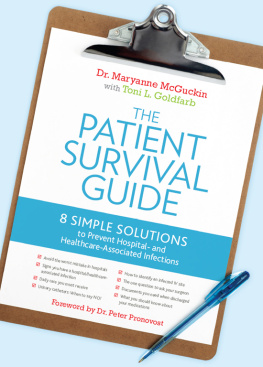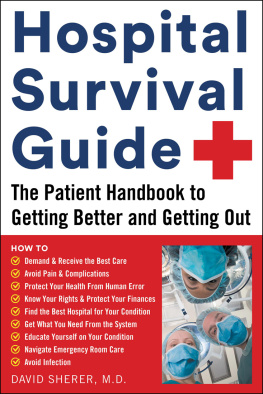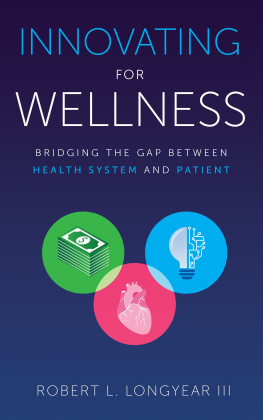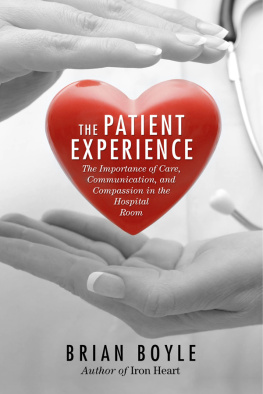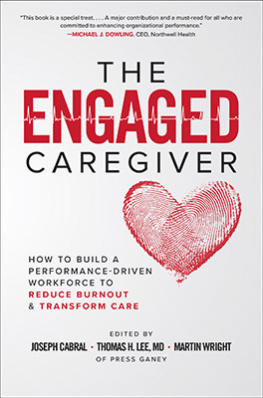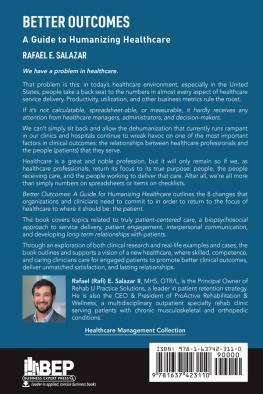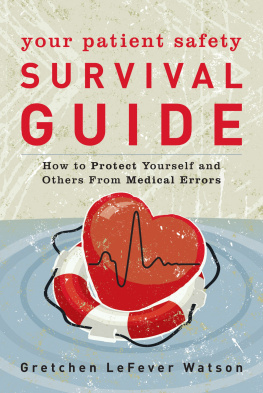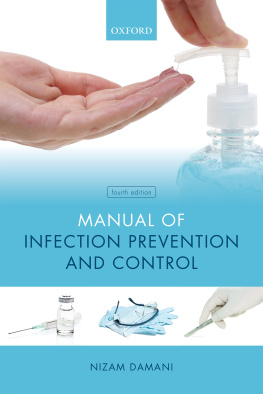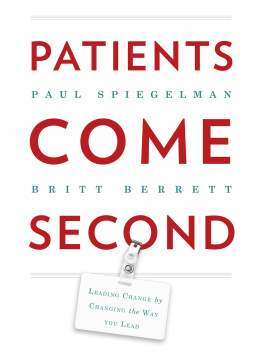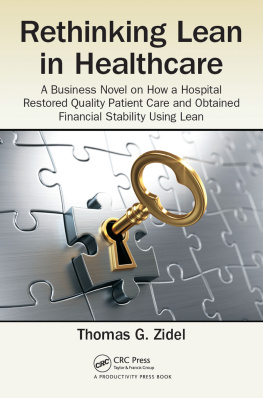Dr. McGuckin sounds the alarm on deadly, costly infections and how to prevent them. Before you or a loved one heads to the hospital, reach for this guidebook. It could save a life.
CECI CONNOLLY, former national health correspondent, The Washington Post
Following on from her pioneering work in championing patient empowerment in healthcare, Maryanne McGuckin goes a step further in The Patient Survival Guide to give the patient the knowledge needed to make the healthcare experience a safe one. This book is written in simple language to demystify the coded jargon for the layman consumer, but with all the experience of a confirmed and respected healthcare infection control expert.
DIDIER PITTET, MD, MD, CBE, Director, Infection Control Program and WHO Collaborating Centre on Patient Safety; Lead, WHO Global Patient Safety Challenge Clean Care is Safer Care
An informative book not only for patients and their families but also for the healthcare provider. This book should inspire us all to work together to prevent needless deaths from hospital-acquired infections (and medical errors).
Sorrel King, Josie King Foundation and author of Josie's Story
Receiving medical care at a hospital without acquainting yourself with the important information in The Patient Survival Guide is like jumping out of an airplane with no parachute and then hoping you grow wings on the way down.
VICTORIA NAHUM, Co-founder and Executive Director, Safe Care Campaign
The Patient Survival Guide empowers consumers to be active and effective advocates for themselves and/or loved ones navigating the complex healthcare system. A great resource for patient advocates and a valuable addition to every hospital waiting room!
BETH BOYNTON, RN, MS, Author, Confident Voices: The Nurses' Guide to Improving Communication & Creating Positive Workplaces
This is the best book I've ever read that explains everything a lay person needs to know about hospital-acquired infections. If you want to survive your hospital stay without an infection, read it.
ROSEMARY GIBSON, Author, Wall of Silence and The Treatment Trap

THE PATIENT SURVIVAL GUIDE
8 Simple Solutions to Prevent Hospital- and Healthcare-Associated Infections
by
Dr. Maryanne McGuckin
with Toni L. Goldfarb

Visit our website at www.demoshealth.com
ISBN: 978-1-936303-31-1
e-book ISBN: 9781617051180
Acquisitions Editor: Noreen Henson
Compositor: Diacritech
2012 by Maryanne McGuckin. All rights reserved. This book is protected by copyright. No part of it may be reproduced, stored in a retrieval system, or transmitted in any form or by any means, electronic, mechanical, photocopying, recording, or otherwise, without the prior written permission of the publisher.
Medical information provided by Demos Health, in the absence of a visit with a healthcare professional, must be considered as an educational service only. This book is not designed to replace a physician's independent judgment about the appropriateness or risks of a procedure or therapy for a given patient. Our purpose is to provide you with information that will help you to make your own healthcare decisions.
The information and opinions provided here are believed to be accurate and sound, based on the best judgment available to the authors, editors, and publisher, but readers who fail to consult appropriate health authorities assume the risk of injuries. The publisher is not responsible for errors or omissions. The editors and publisher welcome any reader to report to the publisher any discrepancies or inaccuracies noticed.
CIP data is available from the Library of Congress.
Special discounts on bulk quantities of Demos Health books are available to corporations, professional associations, pharmaceutical companies, healthcare organizations, and other qualifying groups. For details, please contact:
Special Sales Department
Demos Medical Publishing, LLC
11 West 42nd Street, 15th Floor
New York, NY 10036
Phone: 800-532-8663 or 212-683-0072
Fax: 212-941-7842
E-mail:
Printed in the United States of America by Bang Printing
12 13 14 15 / 5 4 3 2 1
In memory of my parents,
John and Anna McGuckin.

Foreword
H ealthcare is an extremely complex industry and patients often end up seeing a different doctor for every part and organ of their bodies, from a podiatrist for their feet, to a neurologist for their brains. In the context of the hospital setting, this equates to many different physicians, nurses, and other healthcare professionals caring for one patient. Compound this by the many patients each professional sees, and you will realize how easily mistakes can occur and memories fail. The one person who can best manage their care in today's complex health care system is the patient. There is no mistaking that people will err, and errors can kill, yet teams can perform flawlessly.
Far too many patients are still harmed rather than helped from their interactions with the healthcare system. While reducing this harm has proven to be devilishly difficult, we have found that checklists help. Checklists help to reduce ambiguity about what to do, to prioritize what is most important, and to clarify the behaviors that are most helpful. Nonetheless, there has been some hope in recent years with reductions in bloodstream infections contracted from central lines used in the intensive care unit. While these lines are used to provide life-saving treatments, they require specific practices to prevent infectiona checklist and collaboration among clinicians helped to dramatically reduce bloodstream infections at The Johns Hopkins Hospital, in hospitals throughout Michigan, and across the United States. Clinicians have begun to develop, implement, and evaluate checklists for a variety of other diagnoses and procedures.
Yet, vigilance is unconsciously fickle; clinicians are distracted by competing priorities and unconsciously miss a vital step; too often patients suffer. Unfortunately, asking a physician or nurse to pay more attention is not the answer. There are no quick fixes and healthcare professionals need an extra set of eyes from patientspatients who are the central focus of care.
Patients can also use checklists to defend themselves against the major causes of preventable harm. Here are a few you can use:
Healthcare-Associated Infections
- Ask what the current rate of central line-associated bloodstream infections is in your hospital's intensive care unit. The best hospitals will have a rate of less than one infection per 1,000 catheter days (the definition provided by the Centers for Disease Control and Prevention). A rate above three should cause concern.
- Whenever clinicians enter your room, ask if they have washed their hands. Request that visitors also wash their hands often. Washing can be with alcohol gel or soap and water.
- If you have any type of catheter (tube), ask every day if it can be removed.
Identify Errors
- If you are admitted to the hospital, check your ID bracelet to make sure all of the information is correct. Every staff person should use this bracelet to confirm your name before any treatments or tests.
Next page
